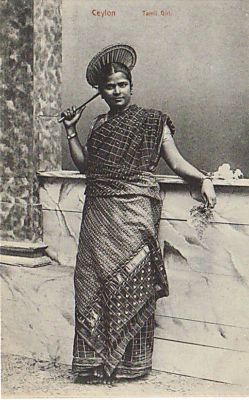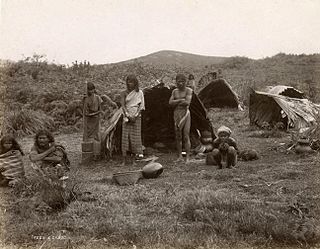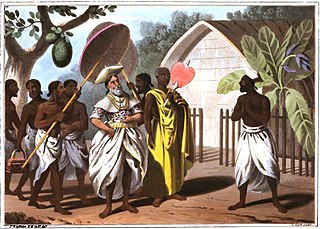
Indian Tamils of Sri Lanka are Tamil people of Indian origin in Sri Lanka. They are also known as Malayaga Tamilar, Hill Country Tamils, Up-Country Tamils or simply Indian Tamils. They predominantly descend from workers sent from Southern India to Sri Lanka in the 19th and 20th centuries to work in coffee, tea and rubber plantations. Some also migrated on their own as merchants and as other service providers. These Tamil speakers mostly live in the central highlands, also known as the Malayakam or Hill Country, yet others are also found in major urban areas and in the Northern Province. Although they are all termed as Tamils today, some have Telugu and Malayalee origins as well as diverse South Indian caste origins. They are instrumental in the plantation sector economy of Sri Lanka. In general, socio-economically their standard of living is below that of the national average and they are described as one of the poorest and most neglected groups in Sri Lanka. In 1964 a large percentage were repatriated to India, but left a considerable number as stateless people. By the 1990s most of these had been given Sri Lankan citizenship. Most are Hindus with a minority of Christians and Muslims amongst them. There are also a small minority followers of Buddhism among them. Politically they are supportive of trade union-based political parties that have supported most of the ruling coalitions since the 1980s.
The caste systems in Sri Lanka are social stratification systems found among the ethnic groups of the island since ancient times. The models are similar to those found in Continental India, but are less extensive and important for various reasons. Modern times Sri Lanka is often considered to be a casteless society in south asia.

Salagama is a Sinhalese caste found mostly in the southern coastal areas of Sri Lanka. The community was traditionally associated with the cultivation and management of cinnamon and were formerly also involved as weavers and soldiers.

Sri Lankan Tamils, also known as Ceylon Tamils or Eelam Tamils, are Tamils native to the South Asian island state of Sri Lanka. Today, they constitute a majority in the Northern Province, form the plurality in the Eastern Province and are in the minority throughout the rest of the country. 70% of Sri Lankan Tamils in Sri Lanka live in the Northern and Eastern provinces.
The Donoughmore Commission (DC) was responsible for the creation of the Donoughmore Constitution in effect between 1931 and 1947 in Ceylon. In 1931 there were approximately 12% Ceylonese Tamils, 12% Indian Tamils, 65% Sinhalese, and ~3% Ceylon Moors. The British government had introduced a form of communal representation which a strong Tamil representation, out of proportion to the population of the Tamil community. The Sinhalese had been divided into up-country and low-country Sinhalese.
Sri Lankan Mukkuvar is a Tamil speaking ethnic group found in the Western and Eastern coastal regions of Sri Lanka. They are primarily concentrated in the districts of Puttalam, Batticaloa, and Amparai.
Nalavar is a Tamil caste found in Sri Lanka. They were traditionally occupied in palm tree climbing and toddy tapping.
Koviyar is a Tamil caste found in Sri Lanka. They are traditional agriculturalists and temple workers but also included merchants, landowners and temple patrons. Kattavarayan as caste deity is observed by the Koviar. They are reputed as a ritually dominant caste and regarded as the "cousin" caste of the more numerical dominant caste, Sri Lankan Vellalar.
Karaiyar is a Sri Lankan Tamil caste found mainly on the northern and eastern coastal areas of Sri Lanka, and globally among the Tamil diaspora.

Karava is a Sinhalese speaking ethnic group of Sri Lanka, whose ancestors migrated throughout history from the Coromandel coast, claiming lineage to the Kaurava royalty of the old Kingdom of Kuru in Northern India. The Tamil equivalent is Karaiyar. Both groups are also known as the Kurukula.

Rodi or Rodiya are an untouchable Buddhist social group or caste amongst the Sinhalese people of Sri Lanka. Their status was very similar to all the Untouchable castes of India with segregated communities, ritualised begging, economically weakest section of the society.
Govigama is a Sinhalese caste found in Sri Lanka. They form approximately half of the Sinhalese population and are traditionally involved in agriculture. The term Govigama became popular during the last period of the Sinhalese Kingdom of Kandy. Its members have dominated and influenced national politics and Sinhalese Buddhism.

Radala refers to a small minority group in Sri Lanka in the former provinces of the Kingdom of Kandy, who are either descendants of chiefs and courtiers of the King of Kandy of Nayaks of Kandy or descendants of native headmen appointed by the British colonial administration following the Uva Rebellion in 1818.
Hēna, also Radā, is a minority Sinhalese caste. "Rajas" means dirt in Sinhala and Pali or Sanskrit and "Rajaka" means the removers of dirt. They collected cloths by traveling home to home of higher castes but now that was obsolete in Sri Lanka.but still they performs several rituals in the weddings and the females of this caste performs vital role in the puberty rituals of Radala and Govigama people in some areas of Sri Lanka. They called "Redi nanda" for females and "Hene mama" for males by the Sri Lankan society because they were given some respect unlike the other Asian countries due to the influence of buddhism in early periods.
Sri Lankan Vellalar is a caste in Sri Lanka, predominantly found in the Jaffna peninsula and adjacent Vanni region, who comprise about half of the Sri Lankan Tamil population. They were traditionally involved in agriculture, but also included merchants, landowners and temple patrons. They also form part of the Sri Lankan Tamil diaspora.
Vanniar or Vanniyar was a title borne by chiefs in medieval Sri Lanka who ruled in the Chiefdom of Vavuni regions as tribute payers to the Jaffna vassal state. There are a number of origin theories for the feudal chiefs, coming from an indigenous formation. The most famous of the Vavni chieftains was Pandara Vannian, known for his resistance against the British colonial power.
Social class in Sri Lanka is often described as casteless, though caste is still found on the island in both a symbolic and a practical sense. Caste is also used in an analogous sense to refer to the new social class divisions that have appeared in recent decades. The combination of ethnic nationalist movements that saw caste as an island-wide dividing tool, strong emphasis on providing access to education and healthcare regardless of background, and historic lack of discrimination among the colonial civil service played a factor in eradicating the caste system in most sectors of the island's society. Although the Buddhist culture actively fought against all forms of class discrimination, many Buddhist organizations used caste as a method to extract surplus from temple property.
A national list member of parliament is a nominated member of parliament who is appointed by a political party or an independent group to the Parliament of Sri Lanka. The number of national list MPs allocated to a contesting party or an independent group depends on the proportion to their share of the national vote. A total of 29 national list MPs are appointed alongside 196 elected MPs making a total of 225 members in the parliament.

Chellappah Suntharalingam was a Sri Lankan Tamil academic, politician, Member of Parliament and government minister.
Madapalli is a caste found mainly in the northern part of Sri Lanka. Found today as a subcaste of the Sri Lankan Vellalar, the Madapallis were considered an independent caste until recently.






